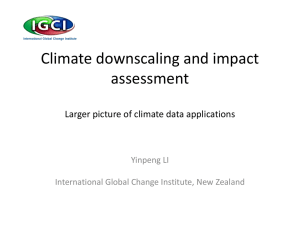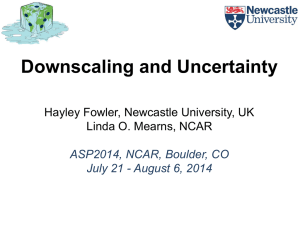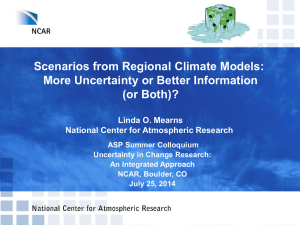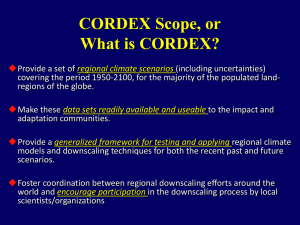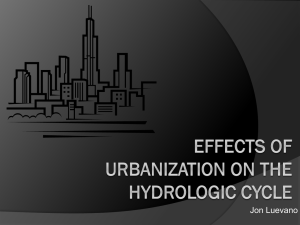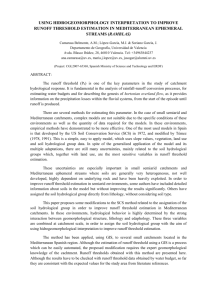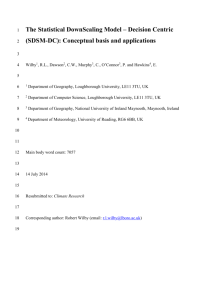DRAFT guidance on water and climate adaptation FOR
advertisement
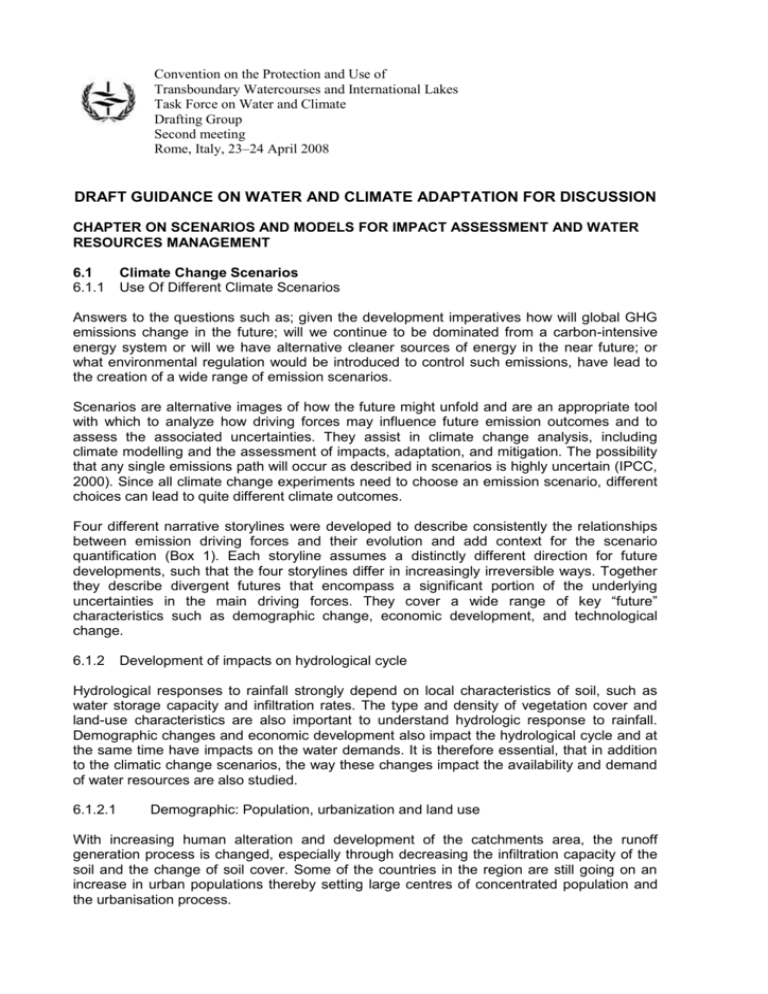
Convention on the Protection and Use of Transboundary Watercourses and International Lakes Task Force on Water and Climate Drafting Group Second meeting Rome, Italy, 23–24 April 2008 DRAFT GUIDANCE ON WATER AND CLIMATE ADAPTATION FOR DISCUSSION CHAPTER ON SCENARIOS AND MODELS FOR IMPACT ASSESSMENT AND WATER RESOURCES MANAGEMENT 6.1 6.1.1 Climate Change Scenarios Use Of Different Climate Scenarios Answers to the questions such as; given the development imperatives how will global GHG emissions change in the future; will we continue to be dominated from a carbon-intensive energy system or will we have alternative cleaner sources of energy in the near future; or what environmental regulation would be introduced to control such emissions, have lead to the creation of a wide range of emission scenarios. Scenarios are alternative images of how the future might unfold and are an appropriate tool with which to analyze how driving forces may influence future emission outcomes and to assess the associated uncertainties. They assist in climate change analysis, including climate modelling and the assessment of impacts, adaptation, and mitigation. The possibility that any single emissions path will occur as described in scenarios is highly uncertain (IPCC, 2000). Since all climate change experiments need to choose an emission scenario, different choices can lead to quite different climate outcomes. Four different narrative storylines were developed to describe consistently the relationships between emission driving forces and their evolution and add context for the scenario quantification (Box 1). Each storyline assumes a distinctly different direction for future developments, such that the four storylines differ in increasingly irreversible ways. Together they describe divergent futures that encompass a significant portion of the underlying uncertainties in the main driving forces. They cover a wide range of key “future” characteristics such as demographic change, economic development, and technological change. 6.1.2 Development of impacts on hydrological cycle Hydrological responses to rainfall strongly depend on local characteristics of soil, such as water storage capacity and infiltration rates. The type and density of vegetation cover and land-use characteristics are also important to understand hydrologic response to rainfall. Demographic changes and economic development also impact the hydrological cycle and at the same time have impacts on the water demands. It is therefore essential, that in addition to the climatic change scenarios, the way these changes impact the availability and demand of water resources are also studied. 6.1.2.1 Demographic: Population, urbanization and land use With increasing human alteration and development of the catchments area, the runoff generation process is changed, especially through decreasing the infiltration capacity of the soil and the change of soil cover. Some of the countries in the region are still going on an increase in urban populations thereby setting large centres of concentrated population and the urbanisation process. Urbanisation disrupts natural drainage patterns; natural watercourses are destroyed and the natural retention of runoff by plants and soil is removed. By changing pervious natural surfaces to less- or non-pervious artificial surfaces, the storm water runoff rates and the total runoff volumes will increase as a result of a declining natural water storage capacity of the soil. Change of natural water storage as a consequence of urbanisation also causes significant changes to the temporal characteristics of runoff from an urbanised area, such as shortening the runoff travel time and giving to the event a flashing appearance. All these factors are leading to an increased risk of urban flooding The increase in population and need for more food production and bio-energy needs, results in the intensification of agriculture. With the intensive cultivation practices the hydrological response of the catchments is likely to change. The agricultural practices such as soil tillage, soil drainage system, choice of crops etc have an influence on the runoff generation process. Deforestation and afforestation, both have key land use change with profound hydrological impacts. It is increasingly realised that the hydrological consequences of upper catchment afforestation need to be understood and taken in to account so that existing downstream users are not compromised. Trees generally consume more water than shorter stature vegetation growing under the same environmental conditions. BOX 1: The Emission Scenarios The Special Report of Emission Scenarios (SRES) The A1 storyline and scenario family describes a future world of very rapid economic growth, global population that peaks in mid-century and declines thereafter, and the rapid introduction of new and more efficient technologies. Major underlying themes are convergence among regions, capacity building, and increased cultural and social interactions, with a substantial reduction in regional differences in per capita income. The A1 scenario family develops into three groups that describe alternative directions of technological change in the energy system. The three A1 groups are distinguished by their technological emphasis: fossil intensive (A1FI), non-fossil energy sources (A1T), or a balance across all sources (A1B) The A2 storyline and scenario family describes a very heterogeneous world. The underlying theme is self-reliance and preservation of local identities. Fertility patterns across regions converge very slowly, which results in continuously increasing global population. Economic development is primarily regionally oriented and per capita economic growth and technological change is more fragmented and slower than in other storylines. The B1 storyline and scenario family describes a convergent world with the same global population that peaks in mid-century and declines thereafter, as in the A1 storyline, but with rapid changes in economic structures toward a service and information economy, with reductions in material intensity, and the introduction of clean and resource-efficient technologies. The emphasis is on global solutions to economic, social, and environmental sustainability, including improved equity, but without additional climate initiatives. The B2 storyline and scenario family describes a world in which the emphasis is on local solutions to economic, social, and environmental sustainability. It is a world with continuously increasing global population at a rate lower than A2, intermediate levels of economic development, and less rapid and more diverse technological change than in the B1 and A1 storylines. While the scenario is also oriented toward environmental protection and social equity, it focuses on local and regional levels. Source: EMISSIONS SCENARIOS. A Special Report of WG III of the IPCC. SPM 6.1.2.2 Economic Development Economic development in many countries in Europe has to be accelerated. The better living conditions and well-being is likely to put greater pressure on the natural resources particularly water and energy. This is likely to impact the land use patterns, the demand patterns, the waste water generation which have their own impacts on the hydrological processes. These issues would have to be factored in understanding the impact of climate change. 6.1.3 Developing Integrated Scenarios Based on the current and future social and economic goals set out by the countries different demographic and economic scenarios would have to be developed. These will essentially be very different in different countries and would including the need to take mitigation actions. These scenarios would have to be combined with different climate scenarios. 6.2 Global And Regional Climate Models Global climate models (GCMs) estimate the effect that the emissions have on the global climate. GCMs describe important physical elements and processes in the atmosphere, oceans and land surface that make up the climate system. One disadvantage of GCMs is their scale, which is typically a few hundred kilometres in resolution. However, GCMs are not designed for climate change impact studies on a local scale and do not permit a good estimation of hydrological responses to climate change by themselves. The outputs of GCMs have to be downscaled. 6.2.1 Use Of Different Global Circulation Models Models have proven to be extremely important tools for simulating and understanding climate. According to the IPCC 4th AR there is considerable confidence that models are able to provide credible quantitative estimates of future climate change, particularly at larger scales. However, models continue to have significant limitations which lead to uncertainties of predicted climate change, mostly in the magnitude and timing, as well as in regional details. The mathematical models used to simulate both the present climate and the projected future climate changes are generally referred to as General Circulation Models or Global Climate Models (GCMs). GCMs are computationally intensive numerical models based on the integration of a variety of fluid dynamical, chemical, and sometimes biological equations. As the spatial resolution of GCMs remains quite coarse, in the order of grid box size of 100– 200 km, the influence on regional and local details of the climate caused by topography (regional water masses, orographic effects) is lost. On the other hand, hydrological modelling for water resources assessment require input data (such as precipitation and temperature) at a much smaller scale (usually sub-grid scales of 10 to 100 km depending from the Use the model best simulating the historical records. A GCM-average pattern might be considered to give a better presentation of regional anthropogenic climate change than the pattern derived from any single GCM (Hulme et al., 2000). Due to model uncertainty, an ensemble of models is more accurate than any single model. As a first analysis, the multi-model projections of specific variables (temperature, precipitation, humidity etc.) are analyzed. However, we must check that the models are capturing the large scale climate circulations. At the same time one has to ensure that the climatology (usually the average of each month for all the years of analysis) is matched with the historical runs in order to verify how “good” the models is in representing past climates. 6.2.2 Downscaling GCMs Because of this impediment in representing local (sub grid) basin-scale features and dynamics, to assess the hydrological impact of climate change for water management purposes there is the need to convert the GCM outputs into at least a reliable daily precipitation and temperature time series at the basin-scale. The methods used to convert GCM outputs into local meteorological variables required for reliable hydrological modelling are usually referred to as ‘downscaling’ techniques. These techniques have emerged as a mean of bridging the gap between what climate modellers are currently able to provide and what impact assessors require. There are various downscaling techniques available to convert GCM outputs in to daily meteorological variables appropriate for hydrologic impact studies, which can be divided in two broad categories of downscaling: dynamic (simulating physical processes at sub-grid scales) and statistical (transforming coarse-scale climate projections to a smaller scale based on observed relationships between the climate at the two spatial resolutions). The choice of most appropriate downscaling technique depends in part on the variables, seasons, and regions of interest. 6.2.2.1 Dynamic downscaling and RCMs The Regional Climate Models (RCMs) use the same formulation of the climate system as in the GCM which helps to ensure that the RCM provides high-resolution regional climate change projections generally consistent with the continental scale climate change projected by the GCM (Jones et al., 2004). Nesting a fine scale climate model in a coarse scale model, dynamic downscaling produces spatially continuous fields of climate variables, thus preserving some spatial correlation as well as physically plausible relationships between variables. However, dynamic downscaling is very computationally intensive, making its use in impact studies limited, and essentially impossible for multi-decade simulations with different global climate models and/or multiple greenhouse gas emission scenarios. Thus, most impacts studies rely on some form of statistical downscaling, where variables of interest can be downscaled using historical observations. There has been extensive work on developing and making inter-comparison of statistical downscaling techniques. (Giorgi et al., 2001; Wilby and Wigley, 1997). High-resolution regional data (with horizontal resolutions of 50 km) for actual climate and climate change projections are provided by the Hadley Centre. The Hadley Centre’s current version of the RCM (HadRM3P) is based on HadAM3H, an improved version of the atmospheric component of the latest Hadley Centre coupled AOGCM, HadCM3 (run under SRES A2 emission scenario). Within Europe, ECMWF is at work to address issues in regional downscaling. 6.2.2.2 Statistical downscaling Statistical downscaling is typically used to predict one variable at one site, though some techniques for simultaneous downscaling to multiple sites for precipitation have been developed (Harpham and Wilby, 2005; Wilks, 1999). However, for studies of some climate impacts such as river basin hydrology, it is important to downscale simultaneous values of multiple variables (such as precipitation and temperature) over large, heterogeneous areas, while maintaining physically plausible spatial and temporal relationships, though few downscaling techniques have been developed to do this. Statistical downscaling involves the derivation, validation, and application of a statistical model (usually based on regression analysis) that relates regional-scale predictors to local-scale climate variables. Requiring access to large data sets and considerable expertise to derive the statistical relationships, statistical downscaling can be difficult to apply from first principles. However, user-friendly software to facilitate use is available Statistical downscaling may be used whenever impacts models require small-scale data, provided that suitable observed data are available to derive the statistical relationships. The most widely used statistical downscaling methods are the multiple linear regression and stochastic weather generation. However, the interest in nonlinear regression methods, namely, artificial neural networks (ANN), is nowadays increasing because of their high potential for complex, nonlinear and time-varying input-output mapping. 6.2.2.3 Comparison of dynamical and statistical downscaling 1 The general conclusion is that both methods give comparable results in terms of their skill in reproducing the mean and variability of present-day climatic or river flow conditions, on both daily and monthly time scales. In the past, Statistical Downscaling methods were viewed as a complementary technique to Regional Climate Models (RCMs) for downscaling regional climate, each approach having distinctive strengths and weaknesses. The conclusion that Statistical Downscaling methods and RCMs are comparable for simulating current climate still holds (IPCC TAR). The bottom line here is that statistical and dynamical downscaling (whether with a nested RCM or a high-resolution global model) complements each other, and, where possible, both should be carried out in parallel. 6.3 Expected Climate Changes In order to comprehensively understand the impacts of climate change on the water resources systems and to develop the adaptation strategies projections of future climate in 1 There have been a number of studies comparing dynamical downscaling using RCMs and statistical downscaling (e.g., Kidson and Thompson 1998; Murphy 1999, 2000; Hellström et al. 2001; and Hanssen-Bauer 2003. See also Giorgi et al. 2001 and Yarnal et al. 2001). Specific impacts-related papers include Wilby et al. (1999, 2000), Wilby and Dettinger (2000), and Hay and Clark (2003). terms of changes in: air temperature, total precipitation rate, potential evaporation, soil moisture content and wind speed is required. Out of all the climatic factors, the daily and inter-annual variation in precipitation is crucial for rain-fed and runoff for irrigated production. In both rain-fed and irrigated systems, the spatial and temporal variation of precipitation is the key. The day-to-day variability of rainfall associated with weather is the major risk factor for most forms of agriculture. Soil moisture deficits, crop damage and crop disease are all driven by rainfall and associated humidity. This susceptibility of agriculture to such high frequency variability in rainfall intensity and duration make the projection of performance of agricultural systems in relation to long term climate trends very difficult to determine. 6.4 Direct and indirect impacts of CC on Water The climate change is likely to directly and indirectly impact the water resources availability and their management. These are: Water Supplies Flood and Drought Management Water Quality Water Demands System Operations Ecosystems There should be sustained effort to understand the implications of climate change for water resource management. In terms of hydrology and water resources, changes in pattern of rainfall in space and time (intensity-duration-frequency) along with the evapo-transpiration will be the most important determinants of the outcomes of the hydrological process. These changes in precipitation and evaporation will translate directly to shifts in the existing pattern of snowmelt, glacial melt, soil moisture deficits, groundwater recharge and runoff. Second order impacts on streamflow, groundwater, lake and dam storage levels and wetland contraction/expansion will translate into changed availability of water for irrigated production. In particular, groundwater systems are inextricably linked to surface hydrologic systems, which encompass both surface water bodies and the soil zone. Thus, the responses of these various systems will be spatially and dynamically impacted by changes in climate and landuse change. Consideration of the effects of climate change on surface hydrology, land use/land cover, etc. should be taken into account. In addition, climate change is anticipated to result in higher variability and thus more frequent extreme events. Such extreme weather can lead to uncertain responses of groundwater systems. For example, while global scale predictions may suggest an increase in precipitation for a given region, if this precipitation occurs at a higher rate and over a shorter period of time, there may be less recharge to the groundwater system. 6.4.1 Trend Analysis Data needs Detection of changes in long time series of hydrological data is an important scientific issue. It is necessary if we are to establish the true effect of climate change on our hydrological systems, and it is fundamental for planning of future water resources and flood protection. Studies of trend detection are also of importance because of our need to understand the changes of the “natural” world. The process of river flow has been directly influenced by changes caused by man (e.g. land-use changes: urbanisation, deforestation, changes in agricultural practices, and engineering works: drainage systems, dam construction, river GCM Climate scenarios Statistical downscaling / RCM Temperature E + ET Precipitation Hydrological Modelling Development scenarios Runoff GW recharge Water Demand Adaptation Storage Water Resources regulation, etc.). However, also natural changes (e.g. changes in channel morphology, solar activity, etc.) can play a role. By using observations rather than model output, uncertainties inherent in the modelling procedure, such as simplifying assumptions and concepts, are avoided. However, using trend analysis on real data involves other problems, chiefly relating to data quality but also to quantity. (Kundzewicz and Robson, 2000). It is important to assess what changes in climate are detectable in the hydrometric record and in what different aspects they manifest themselves: floods, droughts, timing and at what scale: small to large basins. It is important to minimize other anthropogenic effects while carrying out such an assessment. Credible data are required for analysis of potential change and the selection of the data is based on a common criteria. Local expertise is required for screening the data for the purpose. In order to carry out trend analysis the data used should conform to certain standards. Some of these criterions are listed below. a) Data should be available for 30+ years with some exceptions b) There should be no missing gaps > 4 years c) They should be from suitable location providing broadest possible geographic (spatial) and temporal coverage d) The collection site should be currently in operation and expected to continue e) Data should be available in electronic form f) The data should be accurate and of least “good” quality for daily mean discharges which implies that 95% of values lie within 10% of the true value. g) The data should be from climate sensitive basin i.e., basins with unimpaired basin conditions w.r.t. monthly mean discharge • no known adjustments to create “natural” • no flow diversions • no augmentation • no containment structures • no significant ground water pumping, or mining areas • no significant human activity re land use • only unimpaired portion of record is used • no “constructed” records via adding sites together • no computational algorithms to “fill in” missing records The large contiguous areas of irrigated land associated with river basin deltas are already at risk from a combination of reduced inflows, salinity, annual flood cycles and sea-level rise but are also impacted by urban and industrial pollution. These stresses on some of the prime productive land will continue to compromise agricultural output as these deltas become progressively ‘squeezed’ with attendant loss of biodiversity and the natural ability to recover. In order to identify adaptation measures aimed at mitigation of negative effects of water resources change it is necessary to undertake proper re-assessment of water sources under the new climate and development scenarios, and develop strategy to eliminate shortcomings in the existing water management system as well as mechanisms for regulation, distribution and efficient use of water resources. Expected water deficiency in certain regions resulting from climate change and human activity will require urgent measures on improvement of the water resources management system, regulation of river flow, increase of effective operation of irrigation systems, employment of water saving technologies, and reuse of treated drainage water. Conservation of water resources demands the rehabilitation and expansion of existing water–utilization systems, building of new constructions (dams, canals, dikes, aqueducts, etc.), improvement of existing systems of water-consumption and water-supply. It is necessary to put in order these systems, improve their technical condition, timely carry out maintenance and repair works, equip them with modern water-saving devices. Construction of new reservoirs will considerably improve conditions of runoff regulations and lessen the danger of severe floods. Planning procedures for the design of new infrastructure would have to undergo a philosophical change since the past hydrological characteristics would no more be extendable to represent the future. 6.4.2 Hydrological River Basin Models Hydrological models are mathematical and logical expressions that define quantitative relationships between runoff forming factors (input) and flow characteristics (output). This very general definition covers an entire spectrum of approaches. At one extreme are the empirical, black-box techniques, i.e., those that make no attempt to model the hydrological processes, internal structure and response of the catchments but only attempt to correlate the input and output of the catchments. At the other extreme are techniques involving complex systems of equations based on physical laws and theoretical concepts that govern hydrological/ hydro-geological processes—the so-called conceptual models. It involves solving of systems of the equations based on various concepts of physical processes. Usually such models are called conceptual models. These models represent a logical consideration of simple conceptual elements, e.g., linear or non-linear reservoirs and channels, which simulate processes occurring in the basin. Between these two extremes, there are many variations. Whether black-box or conceptual, these models yield outputs without associated probabilities of occurrence. For this reason, they are often referred to as deterministic models. In order to understand the impact of climate change on the water resources conceptual models that are capable of simulating (a) surface water flows - their generation from precipitation, impacts of land use change on surface water, impacts of land use change on sediment yield, flow of pollutants, and recharge of groundwater etc. ; (b) groundwater flows interaction of groundwater with surface water, groundwater and sea level interaction and the water quality simulation in groundwater; (c) storm surge – their interaction with riverine flows and impacts on flood inundations; and (d) basin planning models. Conceptual models that, through theoretical concepts, treat the varied and interacting hydrological processes are expected to be more trust worthy, particularly in assessing the impacts of climate change. Particularly the models that have been used for and proven effective in simulating the past shall be used. Selection of Models In recent years, several conceptual models have been developed for operational hydrological computations and forecasting. Unless they develop a suitable model themselves, the interested national organizations in charge of hydrological computations and forecasting are faced to the difficulty of ascertaining the relative advantages and disadvantages of the many models proposed for operational use. The selection of a particular model will depend on specific conditions and the objective of modeling. Some of the factors and criteria involved in the selection of a model include the following: i. The purposes ii. The climatic and physiographic characteristics of the basin; iii. The quality of the data available both in time and space; iv. The possible need for reducing model parameters from smaller catchments to larger catchments; and v. The ability of the model to be upgraded on the basis of current hydrometeorological conditions and climate scenarios conditions. It should be stressed that successful calibration and effective operation of a conceptual model is dependent on data sets that include the required observations and are reliable, accurate, consistent, continuous, and of sufficient length. A long-range goal in using these models is to achieve a balance between the basin model and the quality, quantity, and timeliness of the required input data. Historical data collected during routine operations is useful to recalibrate the model and improve its performance. It is important to ensure that the model parameters and state variables have a current set of values at the time that hydrological computations and forecasting are made. Even so, because of data and model errors, simulated runoff will differ from observed one. Therefore, the output from the model should be updated to bring the observed and simulated runoff into closer agreement.2 Future River Basin Hydrology Conceptual models can only simulate runoff for the period for which input data are available. Forecasts for the future will be completed by using predicted values of precipitation and temperature or climatic scenarios. The series of the predicted runoff values are generated under condition of the climate scenarios when conceptual models are in use. It assumes that the historic series are representative to that which can be expected in the future. 6.4.3 Research Needs In order to conceptualize and investigate the relationship between climate and water resources there is a need to couple GCMs and hydrological models. The main problem of coupling these models for the management of water resources systems is that climate scenarios should be compatible with the watershed scale. The limitations of the landatmosphere coupling in the IPCC 4th Assessment notwithstanding, hydrological processes can be expected to exhibit more variability, more extreme events and result in regional shifts in water balances. There is need to establish a data base related to various aspects of climate change, including the historical climatological and hydrological parameters. Such a database shall be 2 Practical applications of different models are described in the WMO, 1990: Hydrological Models for Water Resources System Design and Operation.( Operational Hydrology Report № 34, WMO-№ 740, Geneva). accessible to all the stakeholders including those in the countries sharing the transboundary river basins. In this connection the WMO Resolution 25 regulates the international exchange of hydrological information. As there need to understand the implications of climate change for water resource for their sustainable management addressing the societal goals, a dedicated research team, involving various disciplines, for carrying out scientific activities on this topic needs to be established at the national level. This Centre shall accomplish scientific, practical and operational activities of saving, protection and increase of water resources. References: R. L. Wilby, C. W. Dawson and E. M. Barrow, 2002: SDSM — a decision support tool for the assessment of regional climate change impacts; Environmental Modelling & Software Volume 17, Issue 2, 2002, Pages 145-157 R.L. Wilby, T.M.L. Wigley, 1997: Downscaling general circulation model output: a review of methods and limitations; Progress in Physical Geography, Vol. 21, No. 4, 530-548 R.L. Wilby, P.G. Whitehead, A.J. Wade, D. Butterfield, R.J. Davis and G. Watts, 2006: Integrated modelling of climate change impacts on water resources and quality in a lowland catchment: River Kennet, UK; Journal of Hydrology Volume 330, Issues 1-2, 30 October 2006, Pages 204-220 Yonas B. Dibike, Paulin Coulibaly 2004 “Downscaling global climate model outputs to study the hydrologic impact of climate change part I: calibration and validation of downscaling models”, 6th International Conference on Hydroinformatics - Liong, Phoon & Babovic (eds) © 2004 World Scientific Publishing Company, ISBN 981-238787-0 Giorgi, F., Hewitson, B., Christensen, J., Hulme, M., von Storch, H., Whetton, P., Jones, R., Mearns, L., and Fu, C.: “Regional Climate Information- Evaluation and Projections. Climate Change 2001: The Scientific Basis”. Contribution of Working Group I to the Third Assessment Report of the Intergovernmental Panel on Climate Change, edited by: Houghton, J. T., Cambridge University Press, 583–638, 2001. Harpham, C. and Wilby, R. L.: “Multi-site downscaling of heavy daily precipitation occurrence and amounts”, J. Hydrol., 312, 235–255, 2005. Wilks, D. S.: “Multisite downscaling of daily precipitation with a stochastic weather generator”, Climate Res., 11, 125–136, 1999. Kidson, J. W. and Thompson, C. S., 1998: “Comparison of statistical and modelbased downscaling techniques for estimating local climate variations”. Journal of Climate 11, 735–753 Murphy, J., 1999: “An evaluation of statistical and dynamical techniques for downscaling local climate”. Journal of Climate 12, 2256–2284. Murphy, J., 2000: “Predictions of climate change over Europe using statistical and dynamical downscaling techniques”. International Journal of Climatology 20, 489– 501. Hellström, C., Chen., Achberger, C. and Räisänen, J., 2001: “Comparison of climate change scenarios for Sweden based on statistical and dynamical downscaling of monthly precipitation”. Climate Research 19, 45–55. Hanssen-Bauer, I., Førland, E. J., Haugen, J. E. and Tveito, O. E., 2003: “Temperature and precipitation scenarios for Norway: comparison of results from dynamical and empirical downscaling.” Climate Research 25, 15–27. Yarnal, B., Comrie, A. C., Frakes, B. and Brown, D. P., 2001: “Review. Developments and prospects in synoptic climatology.” International Journal of Climatology 21, 1923– 1950. Wilby, R. L., Hay, L. E., Gutowski, W. J., Arritt, R. W., Takle, E. S., Pan, Z., Leavesley, G. H. and Clark, M. P., 2000: “Hydrological response to dynamically and statistically downscaled climate model output.” Geophysical Research Letters 27, 1199–1202. Wilby, R. L., Hay, L. E. and Leavesley, G. H., 1999: “A comparison of downscaled and raw GCM output: implications for climate change scenarios in the San Juan River basin, Colorado.” Journal of Hydrology 225, 67–91. Wilby, R. L. and Dettinger, M. D., 2000: “Streamflow changes in the Sierra Nevada, California, simulated using a statistically downscaled General Circulation Model scenario of climate change”. (In) Linking Climate Change to Land Surface Change (Eds. S. J. McLaren and D. R. Kniveton). Kluwer Academic Publishers, Netherlands, pp. 99-121. Hay, L. E. and Clark, M. P., 2003: “Use of statistically and dynamically downscaled atmospheric model output for hydrologic simulations in three mountainous basins in the western United States”. Journal of Hydrology 282, 56–75. Harpham, C. and Wilby, R. L.: “Multi-site downscaling of heavy daily precipitation occurrence and amounts”, J. Hydrol., 312, 235–255, 2005. Wilks, D. S.: “Multisite downscaling of daily precipitation with a stochastic weather generator”, Climate Res., 11, 125–136, 1999. Chub,V.E.,Agaltseva,N.A.,Myagkov,S.V. «Climate change impact on the rivers runoff for the Central Asian Rivers» Proceeding of the International Conference on Hydrology and Watershed Management with the Focal Theme on Water Quality and Conservation, Vol.2, p.252-257, Hyderabad, India, 2002 Scibek, J., Allen, D.M., Cannon, A. and Whitfield, P. (2007). Groundwater-Surface Water Interaction Under Scenarios of Climate Change Using a High-Resolution Transient Groundwater Model. Journal of Hydrology, 333: 165-181, doi:10.1016/j.jhydrol.2006.08.005 ANNEX A number of GCMs have been developed by different institutes. These are listed below in the Table 1. To access the model outputs, one has to register and then download them from ftpesg.ucllnl.org. They provide future projections of 110 air, land, and ice and ocean variables. The data is available at 3 hourly, daily, monthly and yearly time scales. As mentioned earlier the outputs for different scenarios used from the IPCC AR4 are available. Among them, the most commonly are the historical (20c3m), A1B, B1, and A2 scenarios. The data is stored in NetCDF format. These are binary files (can’t be seen with text editor or any MS office software). This is due to the large size of the files. To process the files you must use a NetCDF library. To get the outputs for a specific region, you have to “cut” the data, which is stored in a matrix format (longitude, latitude, elevation). Table 1 Global Climate Models


